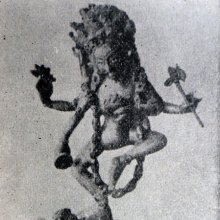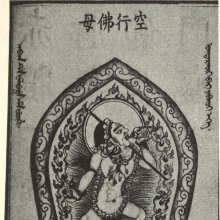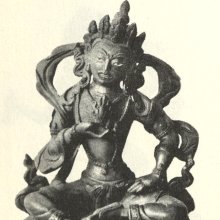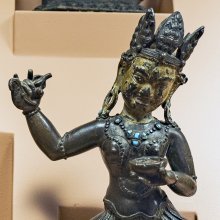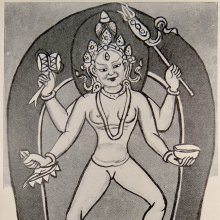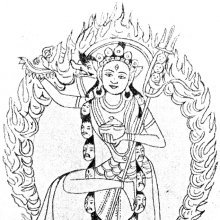Dakini, Ḍākini, Ḍākinī, Dākini: 28 definitions
Introduction:
Dakini means something in Buddhism, Pali, Hinduism, Sanskrit, Jainism, Prakrit, Marathi, Hindi. If you want to know the exact meaning, history, etymology or English translation of this term then check out the descriptions on this page. Add your comment or reference to a book if you want to contribute to this summary article.
Images (photo gallery)
(+5 more images available)
In Hinduism
Shaivism (Shaiva philosophy)
Source: Wisdom Library: Kubjikāmata-tantraḌākinī (डामरी):—Name of one of the eight female deities (yoginīs) of the Yoginīcakra, according to tantric sources such as the Śrīmatottara-tantra and the Gorakṣa-saṃhita. In other tantric sources, such as the kubjikāmata-tantra, she is identified as Ḍāmarī. She is also mentioned as a similarly positioned yoginī in the Kulārṇava-tantra and the Ṣaṭcakranirūpaṇa where she forms part of a group of six or seven such female deities. The male counterpart of Ḍākinī is the Bhairava named Asitāṅga, who should be visualized mentally.
Ḍākinī (and the other eight yoginīs) arise forth from the body of the Bhairava named Saṃvarta, who is described as a furious deity (mahāraudra) with various fearsome characteristics. During worship, She is to be placed in a petal facing east. Ḍākinī has the head of a cat (biḍāla) according to the Śrīmatottara-tantra, or the head of a serpent (sarpa) according to the Kulārṇava-tantra. She has eight arms and holds in her right hands a trident, a knife, a sword and the fearful serpent-king. In her left hands she makes the gesture of reassurance (abhaya) with one hand and holds a shield, a noose and a spear in the other hands. She also wears ear-rings and a neckalce of bones (asthi). Her colour is dark-blue (nīla).
Source: archive.org: Indian Historical Quarterly Vol. 7 (shaivism)Ḍākinī (डाकिनी).—The Ḍākinīs, Rākiṇīs, Lākinīs, [Kākinīs?] Śākinīs and Hākinīs are mentioned as the female energies (Śaktis) of the Tantrik deities respectively called Ḍāmeśvaranātha, Rāmeśvaranātha, Lāmeśvaranātha, Kākeśvaranātha, Śāmeśvaranātha, and Hāmeśvaranātha who together with their Śaktis, form mystic groups designated under the mnemonic ḍa ra la ka śa ha. The Lord of Lāmā is here called Lāmeśvara.

Shaiva (शैव, śaiva) or Shaivism (śaivism) represents a tradition of Hinduism worshiping Shiva as the supreme being. Closely related to Shaktism, Shaiva literature includes a range of scriptures, including Tantras, while the root of this tradition may be traced back to the ancient Vedas.
Purana and Itihasa (epic history)
Source: archive.org: Puranic EncyclopediaḌākini (डाकिनि).—A class of women supposed to be proficient in magic and the performance of feats with the help of mantras. (See Kṣuraka).
Source: archive.org: Shiva Purana - English TranslationḌākinī (डाकिनी) refers to a group of deities who together with the nine Durgās participated in Vīrabhadra’s campaign against Dakṣa, according to the Śivapurāṇa 2.2.33. Accordingly, as Brahmā narrated to Nārada:—“Mahākālī went ahead for the destruction of Dakṣa accompanied by nine Durgās [...]. Eager in executing the command of Śiva, they accompanied the marching heroes—[viz., Ḍākinī] and set out quickly for the destruction of Dakṣa’s sacrifice”.
Source: Cologne Digital Sanskrit Dictionaries: The Purana Index1) Ḍākini (डाकिनि).—An attendant on Śiva.*
- * Brahmāṇḍa-purāṇa III. 41. 30.
2) Ḍākinī (डाकिनी).—A Śakti on the fourth parva of Kiricakra.*
- * Brahmāṇḍa-purāṇa IV. 20. 16.
3) Dākini (दाकिनि).—Evil spirits injuring children.*
- * Bhāgavata-purāṇa X. 6. 27; 63. 10.

The Purana (पुराण, purāṇas) refers to Sanskrit literature preserving ancient India’s vast cultural history, including historical legends, religious ceremonies, various arts and sciences. The eighteen mahapuranas total over 400,000 shlokas (metrical couplets) and date to at least several centuries BCE.
Shaktism (Shakta philosophy)
Source: Google Books: ManthanabhairavatantramDākinī (दाकिनी) is the name of a Yoginī associated with Kāmarūpa, one of the sacred seats (pīṭha), according to the Manthānabhairavatantra, a vast sprawling work that belongs to a corpus of Tantric texts concerned with the worship of the goddess Kubjikā.—The main topic of chapter 35 of the Kumārikākhaṇḍa is the projection of the seats into the Six Wheels of the subtle body, each of which is governed by a Yoginī [i.e., Rākinī, Dākinī]. However, although placing them in pairs in each seat implies this simple linear development of the Wheels from the three seats, two by two from each one, the correspondences are soon skewed. Further ahead in chapter 35, the Wheels (cakra) in the body are again presented in relation to the sacred seats. But there, without any apparent reason, the seats have again become the standard four. Moreover, although the text names only four seats, it refers to them as six.

Shakta (शाक्त, śākta) or Shaktism (śāktism) represents a tradition of Hinduism where the Goddess (Devi) is revered and worshipped. Shakta literature includes a range of scriptures, including various Agamas and Tantras, although its roots may be traced back to the Vedas.
In Buddhism
Tibetan Buddhism (Vajrayana or tantric Buddhism)
Source: Wisdom Library: Tibetan BuddhismḌākinī (डाकिनी) refers to a group of deities summoned by the Yamāntaka-mantra and mentioned as attending the teachings in the 6th century Mañjuśrīmūlakalpa: one of the largest Kriyā Tantras devoted to Mañjuśrī (the Bodhisattva of wisdom) representing an encyclopedia of knowledge primarily concerned with ritualistic elements in Buddhism. The teachings in this text originate from Mañjuśrī and were taught to and by Buddha Śākyamuni in the presence of a large audience (including Ḍākinī).
Source: archive.org: The Indian Buddhist IconographyḌākinī (डाकिनी) refers to one of the four Ḍākinī Goddesses, as mentioned in the 5th-century Sādhanamālā (a collection of sādhana texts that contain detailed instructions for rituals).—In this group of Goddesses are included the names of [viz., Ḍākinī] who are widely mentioned in the Tantric works of rituals. In the sambara-maṇḍala of the Niṣpannayogāvalī their names are mentioned as companion deities of Sambara. Again, in the ṣaṭcakravarti-maṇḍala they are mentioned as companion deities. But their forms are found described only in the Sādhanamālā. According to this authority they [viz., Ḍākinī] are all alike in appearance holding identical symbols.
Source: WikiPedia: Tibetan BuddhismIn the Tibetan language, dakini is rendered Khandroma which means she who traverses the sky or she who moves in space. Sometimes the term is translated poetically as sky dancer or sky walker. The dakini, in all her varied forms, is an important figure in Tibetan Buddhism. She is so central to the requirements for a practitioner to attain full enlightenment as a Buddha that she appears in a tantric formulation of the Buddhist Three Jewels refuge formula known as the Three Roots.
The dakini, in her various guises, serves as each of the Three Roots. She may be a human guru, a vajra master who transmits the Vajrayana teachings to her disciples and joins them in samaya commitments. The wisdom dakini may be a yidam, a meditational deity; female deity yogas such as Vajrayogini are common in Tibetan Buddhism. Or she may be a protector; the wisdom dakinis have special power and responsibility to protect the integrity of oral transmissions
Source: Wisdomlib Libary: VajrayoginiḌākinī (डाकिनी, “lion-faced”) is the name of the goddess found on the eastern petal of the vārāhyabhyudaya-maṇḍala, according to the Vārāhyabhyudayatantra (largerly extracted from the 10th century Abhidhānottaratantra). The central deity of the vārāhyabhyudaya-maṇḍala is the twelve-armed Vajravarāhī, which is modeled upon the twelve-armed Cakrasaṃvara, thus inhibiting many similar iconographical features.
Ḍākinī is to be visualised by the practitioner as a fierce and therianthropic (half-beast, half-human) goddess having three eyes, loose hair and dancing naked in the ardhaparyaṅka pose, with Bhairava and Kālarāri beneath their feet. They are depicted as having four arms, holding a skull and staff in two arms while holding the head of Brahmā and a chopper in the other two arms.
Source: academia.edu: A Critical Study of the Vajraḍākamahātantrarāja (II)Ḍākinī (डाकिनी) or “sacred girls” refers to a group of twenty-four deities residing over twenty-four sacred seats (deśa, kṣetra or sthāna) each associated with internal locations, according to the 9th-centruy Vajraḍākatantra.—Names of twenty-four seats [...] are enumerated and their locations in one’s body is explained (= head, top of the head, right ear and so on). These seats are classified into ten (pīṭhādi = ten groups of lands) beginning with pīṭha (up to upaśmaśāna). Then the text declares that twenty-four sacred girls who are called Ḍākinīs reside on these twenty-four internal seats. These Ḍākinīs have the form of arteries (nādī).
After that, a list of names of such Ḍākinīs and of their internal seats told before is given, accompanied with a list of these Ḍākinīs’ husbands who are called heroes (vīra). These heroes abide in one’s body in the form of twenty-four ingredients (dhātu) of one’s body (fingernails, teeth, hair on the head and body and so on). Such twenty-four districts or seats form three circles (tricakra) i.e. ‘the cicle of mind’ (cittacakra), ‘the circle of word’ (vākcakra) and ‘the circle of body’ (kāyacakra). And the sacred girls (Ḍākinīs) residing on each of tricakra are called respectively ‘a woman going in the sky’ (khecarī), ‘a woman going on the ground’ (bhūcarī) and ‘a woman living underground’ (pātālavāsinī).
Source: academia.edu: The Structure and Meanings of the Heruka MaṇḍalaḌākinī (डाकिनी) refers to one of the twenty-four Ḍākinīs positioned at the padma (lotus) in the middle of the Herukamaṇḍala, according to the 10th century Ḍākārṇava chapter 15. Accordingly, between the east and north (of the heruka-maṇḍala) are six Ḍākinīs who are half black and half dark-blue in color. They [viz., Ḍākinī] are headed by the major four Ḍākinīs of the Cakrasaṃvara tradition. They stand in the Pratyālīḍha posture and, except for the body posture, their physical features and objects that they hold are the same as Vajravārāhīs.
Ḍākinī (डाकिनी) is also mentioned as the Ḍākinī who, together with the Vīra (hero) named Vajraḍāka forms one of the 36 pairs situated in the Vajracakra. Accordingly, the vajracakra refers to one of the four divisions of the sahaja-puṭa (‘innate layer’), situated within the padma (lotus) in the middle of the Herukamaṇḍala. The 36 pairs of Ḍākinīs and Vīras each have one face and four arms; they hold a skull bowl, a skull staff, a small drum and a knife; they are dark-bluish-black in color.
Source: OSU Press: Cakrasamvara SamadhiḌākinī (डाकिनी) (blue) refers to one of the four essence Yoginīs of the Saṃvaramaṇḍala of Abhayākaragupta’s Niṣpannayogāvalī, p. 45 and n. 145; (Cf. Cakrasaṃvaratantra, Gray, David B., 2007).—The Cakrasaṃvara-maṇḍala has a total of sixty-two deities. [...] The four essence Yoginīs, Ḍākinī (blue), Lāmā (green), Khaṇḍarohā (red), and Rūpiṇī (yellow), in counter-clockwise order, east, north, west, and south, in the primary directions.—Ḍākinī is associated with the Bodhipakṣa of kāya-smṛtyupasthāna (“mindfulness of body”).

Tibetan Buddhism includes schools such as Nyingma, Kadampa, Kagyu and Gelug. Their primary canon of literature is divided in two broad categories: The Kangyur, which consists of Buddha’s words, and the Tengyur, which includes commentaries from various sources. Esotericism and tantra techniques (vajrayāna) are collected indepently.
General definition (in Buddhism)
Source: Wisdom Library: BuddhismDakini:—A female spirit who supports Dharma practitioners.
Source: Oxford Reference: A Dictionary of BuddhismIn tantric Buddhism.a ḍākinī is a type of accomplished yoginī or else a female deity, depicted iconographically as a naked semi-wrathful figure who acts as a guiding intermediary for practitioners and assists in the actualization of siddhis. First noted in Indian sources around the 4th century ce, ḍākinīs were probably tribal shamanesses in origin and their name can be linked to cognate terms meaning ‘summoning’ and ‘drumming’ rather than ‘flying’ as suggested by the Tibetan translation which means ‘sky-goer’.
In Jainism
General definition (in Jainism)
Source: archive.org: The Jaina IconographyḌākinī (डाकिनी) is the name of a Yoginī mentioned in various Jaina manuscripts, often being part of a list of sixty-four such deities. How the cult of the Tantrik Yoginīs originated among the vegetarian Jainas is unknown. The Yoginīs (viz., Ḍākinī) are known as attendants on Śiva or Pārvatī. But in the case of Jainism, we may suppose, as seen before that they are subordinates to Kṣetrapāla, the chief of the Bhairavas.

Jainism is an Indian religion of Dharma whose doctrine revolves around harmlessness (ahimsa) towards every living being. The two major branches (Digambara and Svetambara) of Jainism stimulate self-control (or, shramana, ‘self-reliance’) and spiritual development through a path of peace for the soul to progess to the ultimate goal.
Languages of India and abroad
Marathi-English dictionary
Source: DDSA: The Molesworth Marathi and English Dictionaryḍākinī (डाकिनी).—f S pop. ḍāṅkīṇa, ḍākiṇī, ḍāṅkhīṇa f See ḍaṅkhīṇa.
Source: DDSA: The Aryabhusan school dictionary, Marathi-Englishḍākinī (डाकिनी).—f ḍāṅkīṇa, ḍākiṇī, ḍāṅkhīṇa f See ḍaṅkhīṇa.
Marathi is an Indo-European language having over 70 million native speakers people in (predominantly) Maharashtra India. Marathi, like many other Indo-Aryan languages, evolved from early forms of Prakrit, which itself is a subset of Sanskrit, one of the most ancient languages of the world.
Sanskrit dictionary
Source: DDSA: The practical Sanskrit-English dictionaryḌākinī (डाकिनी).—A kind of female imp, a female goblin; Bhāgavata 1.63.1.
Source: Cologne Digital Sanskrit Dictionaries: Shabda-Sagara Sanskrit-English DictionaryḌākinī (डाकिनी).—f. (-nī) A kind of female imp or evil being. ḍākānāṃ samūhaḥ ini .
Source: Cologne Digital Sanskrit Dictionaries: Benfey Sanskrit-English DictionaryḌākinī (डाकिनी).— (probably a form of śākinī), f. A kind of female demon, [Kathāsaritsāgara, (ed. Brockhaus.)] 18, 147.
Source: Cologne Digital Sanskrit Dictionaries: Cappeller Sanskrit-English DictionaryḌākinī (डाकिनी).—[feminine] female imp. witch.
Source: Cologne Digital Sanskrit Dictionaries: Monier-Williams Sanskrit-English Dictionary1) Ḍākinī (डाकिनी):—[from ḍāka] f. (of ka, [Pāṇini 4-2, 51; Patañjali]) a female imp attending Kālī (feeding on human flesh), [Bhāgavata-purāṇa x; Brahma-purāṇa; Mārkaṇḍeya-purāṇa; Kathāsaritsāgara] (ḍāginī, [cii, cviii f.]) (cf. śāk)
2) [v.s. ...] Name of a locality, [Śiva-purāṇa i, 38, 18.]
Source: Cologne Digital Sanskrit Dictionaries: Yates Sanskrit-English DictionaryḌākinī (डाकिनी):—(nī) 3. f. Kind of female imp.
Source: DDSA: Paia-sadda-mahannavo; a comprehensive Prakrit Hindi dictionary (S)Ḍākinī (डाकिनी) in the Sanskrit language is related to the Prakrit word: Ḍāiṇī.
[Sanskrit to German]
Sanskrit, also spelled संस्कृतम् (saṃskṛtam), is an ancient language of India commonly seen as the grandmother of the Indo-European language family (even English!). Closely allied with Prakrit and Pali, Sanskrit is more exhaustive in both grammar and terms and has the most extensive collection of literature in the world, greatly surpassing its sister-languages Greek and Latin.
Hindi dictionary
Source: DDSA: A practical Hindi-English dictionaryḌākinī (डाकिनी):—(nf) a lamia, hellcat, hag.
...
Kannada-English dictionary
Source: Alar: Kannada-English corpusḌākiṇi (ಡಾಕಿಣಿ):—
1) [noun] = ಡಾಕಿನಿ - [dakini -] 1 & 2.
2) [noun] the act or sport of hunting animals.
--- OR ---
Ḍākini (ಡಾಕಿನಿ):—
1) [noun] a female goblin supposed to be fed on the blood in the bodies of dead persons.
2) [noun] her sword.
3) [noun] one of the female members belonging to the retinue of Goddess Kāḷi.
4) [noun] (fig.) a merciless, cruel woman.
Kannada is a Dravidian language (as opposed to the Indo-European language family) mainly spoken in the southwestern region of India.
See also (Relevant definitions)
Starts with: Dakinidosha, Dakinigiri, Dakinijala, Dakinikalpa, Dakinitamtra, Dakinitva, Takini.
Ends with (+2): Anandamandakini, Apavitradakini, Buddhadakini, Chandomandakini, Chhandomandakini, Itakini, Jnanadakini, Mahadakini, Mamdakini, Mandakini, Nandakini, Padmadakini, Pancadakini, Pranavadakini, Putakini, Ratnadakini, Svargamandakini, Tadakini, Takini, Vadavamukhadakini.
Full-text (+1206): Cakravega, Mahabhairava, Dakinitva, Dagini, Raktapa, Vayuvega, Airavati, Shankhini, Khandaroha, Suvira, Hayakarna, Padmini, Candakshi, Dakinidosha, Kamsya, Cakravartini, Subhadra, Mahavirya, Drumacchaya, Mahavira.
Relevant text
Search found 29 books and stories containing Dakini, Ḍākini, Ḍākinī, Dākini, Ḍākiṇi; (plurals include: Dakinis, Ḍākinis, Ḍākinīs, Dākinis, Ḍākiṇis). You can also click to the full overview containing English textual excerpts. Below are direct links for the most relevant articles:
Blue Annals (deb-ther sngon-po) (by George N. Roerich)
Chapter 2a - Niguma: Siddha khyung po rnal 'byor’s biography < [Book 9 - Kodrakpa and Niguma]
Chapter 1 - Shri System (ii): The Lineage of thug rje chen po < [Book 14 - Great Compassion Cycle]
Chapter 9 - Phagmodrupa (ii): Prior incarnations < [Book 8 - The famous Dakpo Kagyü (traditions)]
The Great Chariot (by Longchenpa)
Part 1 - How to practice < [E. Knowing what is to be abandoned and accepted, and how the siddhis are received]
Part 4 - The particular details < [E. Knowing what is to be abandoned and accepted, and how the siddhis are received]
Part 4c - The accompanying samaya and action/practice < [B. The explanation of meditation practice, together with its action of ripening and freeing]
The Shiva Purana (by J. L. Shastri)
Chapter 21 - Number of phallic images of Śiva used in worship < [Section 1 - Vidyeśvara-saṃhitā]
Chapter 33 - The March of Vīrabhadra < [Section 2.2 - Rudra-saṃhitā (2): Satī-khaṇḍa]
Chapter 1 - The greatness of Jyotirliṅgas and their Upaliṅgas < [Section 4 - Koṭirudra-Saṃhitā]
The Indian Buddhist Iconography (by Benoytosh Bhattachacharyya)
Figure 217-218 - Four Ḍākinī Group
Figure 159-160 - Emanations of Vairocana: Vajravārāhī
Figure 152-155 - Emanations of Vairocana: Aṣṭabhuja and Daśabhujasita Mārīcī
Shat-cakra-nirupana (the six bodily centres) (by Arthur Avalon)
Garga Samhita (English) (by Danavir Goswami)
Verse 6.1.32 < [Chapter 1 - Jarāsandha’s Defeat]
Related products
